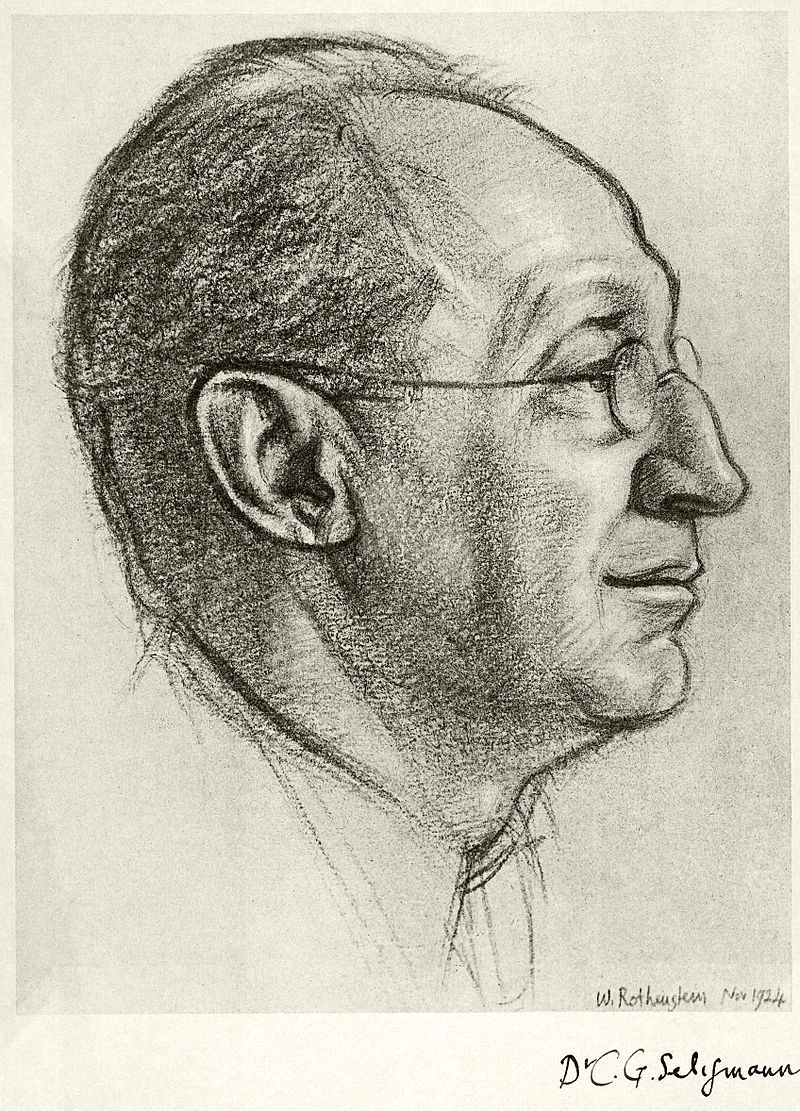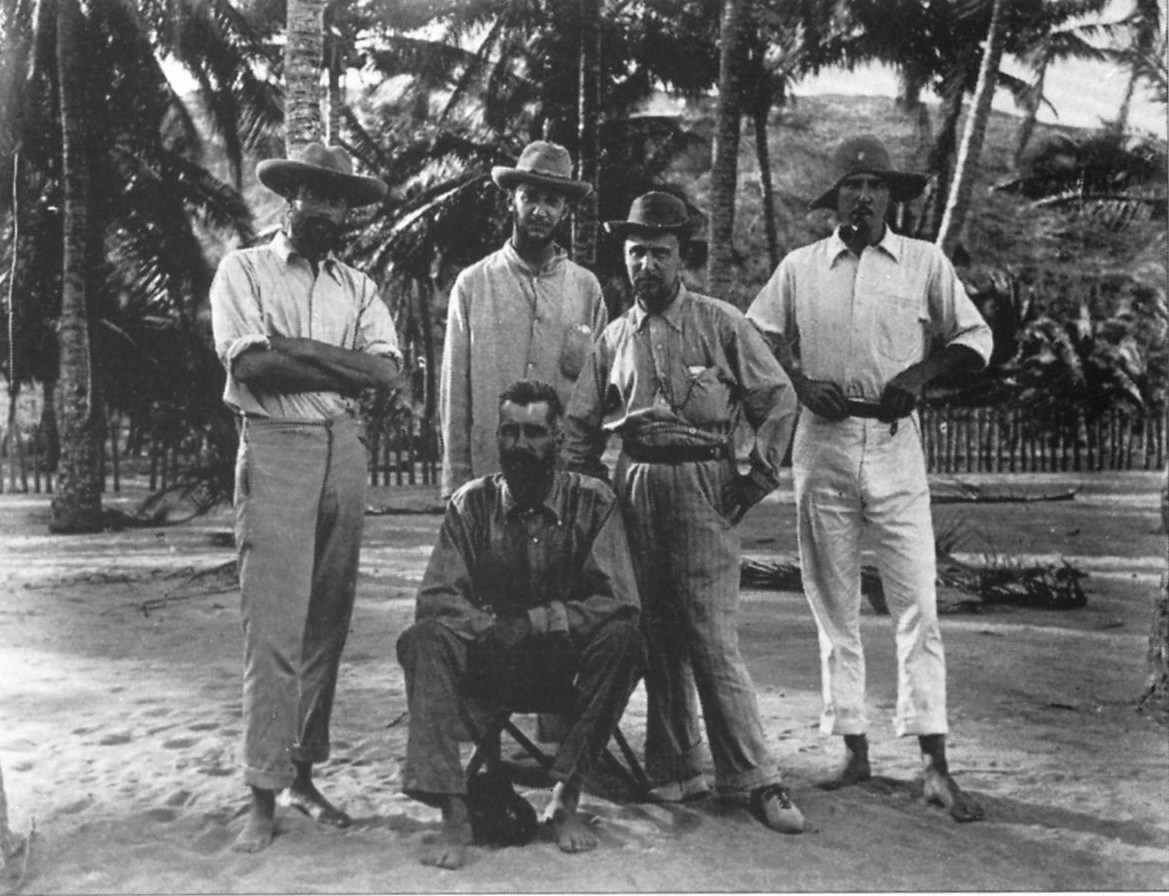
チャールズ・ガブリエル・セリグマン
Charles
Gabriel Seligman, 1873-1940

☆チャールズ・ガブリエル・セリグマン
(Charles
Gabriel Seligman FRS
FRAI、旧姓セリグマン、1873年12月24日-1940年9月19日)はイギリスの医師、民族学者である。彼の主な民族誌的著作は、スリランカの
ヴェッダ族とスーダンのシルック族の文化を記述したものである。ロンドン・スクール・オブ・エコノミクスの教授を務め、ブロニスワフ・マリノフスキ、
E.E.エヴァンス=プリチャード、マイヤー・フォーテスなど、人類学者として大きな影響力を持つようになった人物の師として影響を与えた。セリ
グマンは
ハミティック仮説の提唱者であり、それによれば、アフリカのいくつかの文明はコーカソイドのハミティック人によって築かれたと考えられている。1920年
代から1930年代にかけての彼の研究は、現在では「白人至上主義」とみなされている。
| Charles Gabriel Seligman FRS[1] FRAI (24 December 1873 – 19 September 1940) was a British physician and ethnologist. His main ethnographic work described the culture of the Vedda people of Sri Lanka and the Shilluk people of the Sudan. He was a Professor at London School of Economics and was highly influential as the teacher of such notable anthropologists as Bronisław Malinowski, E. E. Evans-Pritchard and Meyer Fortes all of whose work overshadowed his own.[2] | チャールズ・ガブリエル・セリグマン FRS[1]
FRAI(1873年12月24日 -
1940年9月19日)は、イギリスの医師でありエスノグラファーである。スリランカのヴェッダ族やスーダンのシルック族の文化を記述したのが主な民族誌
学的業績である。ロンドン・スクール・オブ・エコノミクスの教授であり、ブロニスワフ(ブロニスロウ)・マリノフスキー、E・E・エヴァンズ=プリチャー
ド、マイヤー・フォーテスといった著名な人類学者の指導者として大きな影響力を持ち、彼らの研究にはすべてセリグマンの研究の影を落としていと言っても過
言ではない[2]。 |
| Seligman's
work promoted scientific racism and he was a proponent of the Hamitic
hypothesis, according to which, some civilizations of Africa were
thought to have been founded by Caucasoid Hamitic peoples.[3][4][5]
Since the 1960s the Hamitic hypothesis, along with other theories of
"race science", has become entirely discredited in science.[6]: 10 |
セ
リグマンの研究は科学的人種差別を助長するもので、それによると、アフリカのいくつかの文明は、コーカソイドのハム系民族によって築かれたと考えられてい
るハム族仮説の提唱者であった(ハム族仮説とは、ノアの息子ハムはアフリカの人と土地を支配できることを正当
化する仮説)。1960年代以降、ハム族仮説
は、他の「人種科学」の理論とともに、科学的には完全に信用されなくなった。 |
| Seligman
was born into a middle class Jewish family in London, the son of wine
merchant Hermann Seligmann (Charles shortened his name to Seligman
after 1914).[1][7] He studied medicine at St Thomas' Hospital. After
several years as a physician and pathologist, he volunteered his
services to the 1898 Cambridge University expedition to the Torres
Strait.[8] He later joined expeditions to New Guinea (1904), Ceylon
(1906–1908), and Sudan (1909–1912, again in 1921–1922). In 1905, Seligman married Brenda Zara Salaman, who he accompanied on their many expeditions and whom he credited in his publications. She was educated at Bedford College and was skilled at languages and she was able to observe ceremonies that Charles was not allowed to see.[9] From 1913 to 1934, he served as chair of Ethnology at the London School of Economics, where the Anthropology department maintains the Seligman Library in his name.[10] From 1933 he edited the Cresset Historical Series, a book series published by the Cresset Press in London.[11] Seligman was also a Fellow of the Royal Society. |
セ
リグマンはロンドンのユダヤ系中流家庭で、ワイン商のヘルマン・セリグマン(チャールズは1914年以降セリグマンと略称)の息子として生まれた[1]
[7]。その後、ニューギニア(1904年)、セイロン(1906-1908年)、スーダン(1909-1912年、1921-1922年)の探検に参加
した[8]。 1905年、セリグマンはブレンダ・ザラ・サラマンと結婚し、多くの探検に同行し、彼の出版物にも登場する人物である。彼女はベッドフォード・カレッジで 教育を受け、語学に長けており、チャールズが見ることを許されなかった儀式を観察することができた[9]。 1913年から1934年までロンドン・スクール・オブ・エコノミクスで民族学の講座を担当し、人類学部門は彼の名前を冠したセリグマン図書館を維持して いる[10]。 1933年からはロンドンのクレセット出版社から出版された書籍シリーズであるクレセット歴史シリーズを編集した[11]。 セリグマンは王立協会のフェローでもあった。 Members of the 1898 Torres Straits Expedition. Standing (from left to right): Rivers, Seligman, Ray, Wilkin. Seated: Haddon(「ケンブリッジ大学トレス海峡探検隊」) |
| Seligman
is most remembered for his detailed ethnographical work Races of
Africa[citation needed] (1930), which recognises four major distinct
races of the African continent: Bushmanoids (Bushmen), Pygmies,
Negroids, and Caucasoids (Hamites). The Hottentots, Seligman maintains
are a mixture of Bushmanoid, Negroid and Hamitic.[12] As a staunch
proponent of the Hamitic theory, in his work Seligman asserts that
Hamitic Caucasoid North and Northeast Africans were responsible for
introducing non-Semitic Afro-Asiatic languages
(Berber-Cushitic-Egyptian) into Africa, as well as civilization,
technology and all significant cultural developments. In his book,
Seligman states his belief that: "Apart from relatively late Semitic influence...the civilizations of Africa are the civilizations of the Hamites, its history is the record of these peoples and of their interaction with the two other African stocks, the Negro and the Bushmen, whether this influence was exerted by highly civilized Egyptians or by such wider pastoralists as are represented at the present day by the Beja and Somali....The incoming Hamites were pastoral Caucasians – arriving wave after wave – better armed as well as quicker witted than the dark agricultural Negroes."[13][14] Following Giuseppe Sergi's (1901) classification of the Hamites, Seligman divides the Hamites into two groups: (a) "Eastern Hamites" and (b) "Northern Hamites". The former include the "ancient and modern Egyptians... the Beja, the Berberines (Barbara and Nubians), the Galla, the Somali, the Danakil and... Ethiopians". The latter branch includes the Berbers and the "Taureg and Tibu of the Sahara, the Fulbe of Western Sudan and the extinct Guanche of the Canary Islands".[15] Seligman acknowledged varying degrees of Negroid admixture amongst the Hamitic groups, but emphasized throughout his major works the essential racial and cultural unity of the various Hamitic peoples. In his Some Aspects of the Hamitic Problem in the Anglo-Egyptian Sudan (1913), he writes that the Northern and Eastern Hamitic "groups shade into each other, and in many parts a Negro admixture has taken place, nevertheless, culturally if not always physically, either division stands apart from its fellow."[16] The Hamites in general, and the Northern Hamites in particular, he asserted, have close "kinship with the European representatives of the Mediterranean race".[17] Drawing from Coon, Seligman also discusses fairer features observed amongst a minority of Berbers or Northern Hamites, such as lighter skin, golden beards and blue eyes. Races of Africa, however, notably questions the belief held by some anthropologists in the early 20th century that these fairer traits, such as blondism, were introduced by a Nordic variety.[18] In addition, Seligman laid stress on the common descent of Hamites with Semites, writing that "there is no doubt that the Hamites and Semites must be regarded as modifications of an original stock, and that their differentiation did not take place so very long ago, evidence for this statement being furnished by the persistence of common cultural traits and linguistic affinities. Physically their relationship is obvious".[17] |
セリグ
マンは、アフリカ大陸の4つの主要な人種を認識した詳細な民族誌的著作『Races of Africa』[citation needed]
(1930)で最もよく知られています。ブッシュマノイド(ブッシュマン)、ピグミー、ニグロイド、コーカソイド(ハマイト)である。セリグマンは、ホッ
テントットはブッシュマノイド、ネグロイド、ハム系の混合種であると主張している[12]。ハム系説の強固な支持者として、彼の著作では、ハム系コーカソ
イドの北・北東アフリカ人がアフリカに非セム系のアフロアジア言語(ベルベル語、クシ語、エジプト語)、さらに文明、技術、すべての重要な文化発展を導入
した責任があると断言している。セリグマンはその著書の中で次のような信念を述べている。 「アフリカの文明はハマイトの文明であり、その歴史はこれらの民族の記録であり、アフリカの他の二つの民族、ニグロとブッシュマンとの相互作用の記録であ り、その影響が高度に文明化したエジプト人であろうと、現在ベジャやソマリアに代表される広い牧畜民であろうと同じである。 ...流入するハマイトは牧畜民であるコーカサス人であり、次々と到着し、暗い農耕民族であるニグロよりも武装しており、また頭の回転も速かった」 [13][14]。 ジュゼッペ・セルジ(1901年)のハム族の分類に従って、セリグマンはハム族を(a)「東部ハム族」と(b)「北部ハム族」の二つのグループに分けてい る。前者は「古代および現代のエジプト人...ベジャ人、ベルベル人(バルバラ人とヌビア人)、ガラ人、ソマリア人、ダナキル人、...」を含んでいる。 エチオピア人」である。後者にはベルベル人と「サハラのタウレグとティブ、西スーダンのフルベ、カナリア諸島の絶滅したグアンシュ」が含まれる[15]。 セリグマンはハム系民族の間で様々な程度のネグロイド混血を認めたが、彼の主要な著作を通じて、様々なハム系民族の本質的な人種的・文化的統一を強調し た。彼の著書『Some Aspects of the Hamitic Problem in the Anglo-Egyptian Sudan』(1913年)では、北部と東部のハム族は「互いに影を落とし、多くの部分でニグロとの混血が起こっているが、それでも物理的にはともかく文 化的には、どちらの部門もその仲間から離れている」と書いている[16]。 「16] 一般的なハム人、特に北ハム人は、「地中海人種のヨーロッパ人代表と密接な親族関係」にあると彼は主張した[17] クーンから引き続いて、セリグマンは、ベルベル人や北ハム人の少数派に見られる、明るい肌、金の髭、青い目といったより公平な特徴についても論じている。 しかし、『アフリカの人種』は、20世紀初頭に一部の人類学者が持っていた、ブロンドのようなこれらの色白の特徴は北欧の品種によってもたらされたという 信念に特に疑問を呈している[18]。 さらに、セリグマンはハム人とセム人の共通の子孫を強調し、「ハム人とセム人がオリジナルのストックの変更とみなされなければならないこと、そして彼らの 分化がそれほど昔に行われたわけではないことに疑いはなく、この発言に対する証拠は共通の文化特徴や言語の親和性の持続によってもたらされる」と書いてい る。形質的にも両者の関係は明らかである」と記した[17]。 |
| Races
of Africa (1930) upon publication received positive reviews. It was
considered to be the first major published work in English on the
ethnography of Africa, widely regarded as an "ethnological
classic".[19] The anthropologist Alfred L. Kroeber in a review praises
the book for its "vast amount of accurate information" in such concise
form.[20] The first book edition was published by Home University
Library and later in the same year by Oxford University Press, and was
used in many universities, in history and anthropology classes through
to the late 1970s.[21] Races of Africa was also revised four times,
Seligman published a second revised edition in 1939, a year before his
death: "Additions to the original edition published nine years ago
include a note on the importance of the Boskop skull…an account of the
Pygmies as described by Paul Schebesta and a slight alteration in the
classification of the linguistic stocks of the Guinea Coast".[22] A
third edition (revised) appeared in 1957, which was later reprinted by
demand in 1959 and 1961. This edition is notable as it was "brought up
to date" by over a dozen anthropologists, and was very well
received.[23] A final revised edition was published in 1966 and the
book was republished up to 1979. |
ア
フリカの人種、すなわち『Races of Africa
(1930)』は出版と同時に好評を博した。人類学者のアルフレッド・L・クローバーは書評で、このように簡潔な形で「膨大な量の正確な情報」を提供して
いると賞賛している[19]。 [20]
最初の書籍版はホームユニバーシティ図書館から、その後同年にはオックスフォード大学出版局から出版され、1970年代後半まで多くの大学で、歴史学や人
類学の授業で使われた[21]
『アフリカの人種』も4回改訂され、セリグマンは死の前年にあたる1939年に第2回改訂版を出版している。「9年前に出版された原版への追加には、ボス
コップの頭蓋骨の重要性に関する注、ポール・シェベスタによって記述されたピグミー族の説明、ギニア海岸の言語系統の分類の若干の変更などがある」
[22]
1957年に第3版(改訂)が登場し、その後1959年と61年に需要に応じて再版されることになる。この版は十数人の人類学者によって「最新に更新」さ
れたことで注目され、非常に好評であった[23]。 1966年に最終改訂版が出版され、1979年まで再版された。 |
| Melanesians of British New
Guinea (1910) The Veddas (1911) with Brenda Seligman Some Aspects of the Hamitic Problem in the Anglo-Egyptian Sudan (1913) Races of Africa (1930, 1939,1957,1966) The Pagan Tribes of Nilotic Sudan (London: Routledge, 1932) with Brenda Seligman He and his wife's papers are held at the London School of Economics.[24] |
|
| https://en.m.wikipedia.org/wiki/Charles_Gabriel_Seligman. |
https://www.deepl.com/ja/translator. |
 Serving
as chair of ethnology at the London School of Economics between 1913
and 1934, Charles Gabriel Seligman--pictured here during the Torres
Straits Expedition in which he took part--taught Malinowski,
Evans-Pritchard, Schapera and Fortes. In this sense he was the founding
father of our department. The most remembered aspect of his legacy
nowadays, however, is his controversial Races of Africa (1930). Here he
asserted that members of the 'Hamitic race', who had migrated into
central Africa from North and Northeast Africa and who he suggested
were ‘quicker witted’ than the indigenous population, were responsible
for any progress and development in African history. Later discredited,
this theory – known as the Hamitic hypothesis, and adhered to, for
example, by many inhabitants of Somalia, Ethiopia and Sudan who are
shocked to hear themselves described as ‘black’ – was associated with
and served to support racist ideologies and colonial paternalism.
Despite criticism, Seligman kept it unchanged in new editions of the
book into the 1960s. It was for this reason that the library that
formerly bore his name was, in 2018, renamed the Old Anthropology
Library. In line with our commitment to acknowledging these awkward
aspects of our discipline rather than sweeping them aside, we have
posted links to some documents that explore and debate his
controversial legacy. For example, he played a key role during the
1930s in producing an anti-racist statement attacking the
anthropological notion of a pure Aryan race. Such a report was never
produced however, due to the interference of RAI members who were
committed to defending Nazi Germany and that country’s racial policies. Serving
as chair of ethnology at the London School of Economics between 1913
and 1934, Charles Gabriel Seligman--pictured here during the Torres
Straits Expedition in which he took part--taught Malinowski,
Evans-Pritchard, Schapera and Fortes. In this sense he was the founding
father of our department. The most remembered aspect of his legacy
nowadays, however, is his controversial Races of Africa (1930). Here he
asserted that members of the 'Hamitic race', who had migrated into
central Africa from North and Northeast Africa and who he suggested
were ‘quicker witted’ than the indigenous population, were responsible
for any progress and development in African history. Later discredited,
this theory – known as the Hamitic hypothesis, and adhered to, for
example, by many inhabitants of Somalia, Ethiopia and Sudan who are
shocked to hear themselves described as ‘black’ – was associated with
and served to support racist ideologies and colonial paternalism.
Despite criticism, Seligman kept it unchanged in new editions of the
book into the 1960s. It was for this reason that the library that
formerly bore his name was, in 2018, renamed the Old Anthropology
Library. In line with our commitment to acknowledging these awkward
aspects of our discipline rather than sweeping them aside, we have
posted links to some documents that explore and debate his
controversial legacy. For example, he played a key role during the
1930s in producing an anti-racist statement attacking the
anthropological notion of a pure Aryan race. Such a report was never
produced however, due to the interference of RAI members who were
committed to defending Nazi Germany and that country’s racial policies. |
 1913
年から1934年までロンドン・スクール・オブ・エコノミクスの民族学主任を務めたチャールズ・ガブリエル・セリグマンは、この写真は彼が参加したトレス
海峡探検のときのものだが、マリノフスキー、エヴァンス=プリチャード、シャペラ、フォルテスを教えた。この意味で、彼は本学科の創立者である。しかし、
彼の遺産で現在最も記憶されているのは、物議を醸した『アフリカの種族』(1930年)である。ここで彼は、北アフリカと北東アフリカから中央アフリカに
移住してきた「ハミ族」のメンバーが、アフリカの歴史における進歩と発展の責任は、先住民よりも「頭の回転が速い」ことにあると主張した。後に信用されな
くなったが、この説はハム系仮説として知られ、たとえばソマリア、エチオピア、スーダンの住民の多くが、自分たちが「黒人」であると言われることにショッ
クを受けていることから、人種差別的イデオロギーや植民地支配の支持につながり、その支持に役立っている。批判を受けながらも、セリグマンは1960年代
まで、この本の新版でもこの表記を変えなかった。彼の名を冠していた図書館が2018年、旧人類学図書館と改名されたのはこのためである。私たちの学問の
こうした厄介な側面を一掃するのではなく、認めるという私たちのコミットメントに沿って、私たちは彼の論争的な遺産を探求し、議論するいくつかの文書への
リンクを掲載しました。例えば、彼は1930年代に、純粋なアーリア人種という人類学的概念を攻撃する反人種主義的な声明を作成する上で重要な役割を果た
した。しかし、ナチス・ドイツとその国の人種政策を擁護することに熱心だったRAIのメンバーの妨害により、そのような報告書が作成されることはなかっ
た。 1913
年から1934年までロンドン・スクール・オブ・エコノミクスの民族学主任を務めたチャールズ・ガブリエル・セリグマンは、この写真は彼が参加したトレス
海峡探検のときのものだが、マリノフスキー、エヴァンス=プリチャード、シャペラ、フォルテスを教えた。この意味で、彼は本学科の創立者である。しかし、
彼の遺産で現在最も記憶されているのは、物議を醸した『アフリカの種族』(1930年)である。ここで彼は、北アフリカと北東アフリカから中央アフリカに
移住してきた「ハミ族」のメンバーが、アフリカの歴史における進歩と発展の責任は、先住民よりも「頭の回転が速い」ことにあると主張した。後に信用されな
くなったが、この説はハム系仮説として知られ、たとえばソマリア、エチオピア、スーダンの住民の多くが、自分たちが「黒人」であると言われることにショッ
クを受けていることから、人種差別的イデオロギーや植民地支配の支持につながり、その支持に役立っている。批判を受けながらも、セリグマンは1960年代
まで、この本の新版でもこの表記を変えなかった。彼の名を冠していた図書館が2018年、旧人類学図書館と改名されたのはこのためである。私たちの学問の
こうした厄介な側面を一掃するのではなく、認めるという私たちのコミットメントに沿って、私たちは彼の論争的な遺産を探求し、議論するいくつかの文書への
リンクを掲載しました。例えば、彼は1930年代に、純粋なアーリア人種という人類学的概念を攻撃する反人種主義的な声明を作成する上で重要な役割を果た
した。しかし、ナチス・ドイツとその国の人種政策を擁護することに熱心だったRAIのメンバーの妨害により、そのような報告書が作成されることはなかっ
た。 |
| https://www.lse.ac.uk/anthropology/Old-Anthropology-Library/Seligman/Seligman |

Members of the Cambridge Anthropological
Expedition to the Torres Straits, 1898. Standing (from left to right): W. H. R. Rivers,
Charles Gabriel Seligman, Sidney Herbert
Ray, Anthony
Wilkin. Seated: Alfred Cort
Haddon. 1898. Cambridge University Museum of Archaeology and
Anthropology. /Cambridge University Torres Straits Expedition. https://en.m.wikipedia.org/wiki/File:Torres_Straits_1898.jpg
+++
Links
リンク
文献
その他の情報
Copyleft, CC, Mitzub'ixi Quq Chi'j, 1996-2099
☆
 ☆
☆